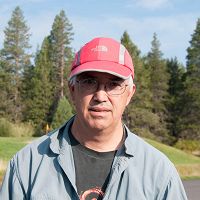Visser et al., 2017
New Applications of Cosmogenic Radioactive Isotopes to Study Water Travel Times
Visser, A.; Thaw, M.; Dinhart, A.; Bibby, R. K.; Esser, B. (2017)
Fall Meeting, American Geophysical Union, December 2017. Abstract H23K-01.
-
Sierra, COLLABORATOR
-
Sierra, GRAD STUDENT
-
Sierra, COLLABORATOR
Plain English Summary
Radioactive isotopes can be used to study how water travels through the environment. Radioactive isotopes of hydrogen, sodium and sulfur are naturally produced in the upper atmosphere. Very few of these isotopes rain down on the Earth's surface and dissolvedin groundwater. Because they are radioactive and decay slowly, the abundance of these isotopes - measured in millions of atoms per liter of water - tells us how long the water spend in the watershed, from the moment it fell as rain until we sampled it as streamflow.
We measured the three isotopes in monthly samples of snow, rain and stream water in the California Sierra Nevada using newly developed laboratory methods. We find that water spends about ten years underground, on average. We find younger water during periods of high flow, and older water during dry periods. This knowledge helps us understand how watersheds work and how they will behave under future climate conditions.
Abstract
The travel time of water moving through a landscape influences nutrient dynamics and biogeochemical cycles. Constraining water travel times helps to understand the functioning of the critical zone. Water travel times cannot be observed directly but can be constrained by measurements of cosmogenic radioactive isotopes.
We studied a small (4.6 km2) subalpine (1660-2117 m) catchment in a Mediterranean climate (8 °C, 1200 mm/yr) in the California Sierra Nevada to assess subsurface water storage dynamics and investigate flow paths and flow velocities. We analyzed a combination of three cosmogenic radioactive isotopes with half-lives varying from 87 days (sulfur-35), 2.6 years (sodium-22) to 12.3 years (tritium) in precipitation and stream samples. Water stable isotopes and solute chemistry aided the interpretation of the cosmogenic isotopes.
Tritium samples (1L) are analyzed by noble gas mass spectrometry after helium-3 accumulation. Samples for sulfur-35 and sodium-22 are collected by processing 20-1000 L of water through an anion and cation exchange column in-situ. Sulfur-35 is analyzed by liquid scintillation counting after chemical purification and precipitation. Sodium-22 is analyzed by gamma counting after eluting the cations into a 4L Marinelli beaker.
Monthly collected precipitation samples show variability of deposition rate for tritium and sulfur-35. Sodium-22 levels in cumulative yearly precipitation samples are consistent with recent studies in the US and Japan. The observed variability of deposition rates complicates direct use as decaying age tracers.
The level and variability of tritium in monthly stream samples indicate a mean residence time on the order of 10 years and only small contributions of younger water during high flow conditions. Sulfur-35 and sodium-22 concentrations were critically interpreted considering possible uptake by vegetation and cation exchange. Detections of sodium-22 confirm a small fraction of younger (< 5 years) water. Low concentrations of sulfur-35 suggest very small contributions of same-year snowmelt or precipitation. Results from two contrasting years (severe drought in 2015 and near-normal conditions in 2016) illustrate travel time responses to hydrological conditions and further characterize the catchment properties.
Citation
Visser, A.; Thaw, M.; Dinhart, A.; Bibby, R. K.; Esser, B. (2017): New Applications of Cosmogenic Radioactive Isotopes to Study Water Travel Times. Fall Meeting, American Geophysical Union, December 2017. Abstract H23K-01..
Explore Further



